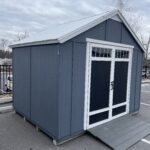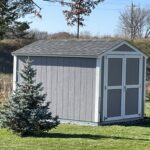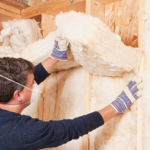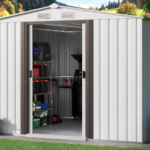Insulating your shed is an excellent idea to protect the items you are storing from extreme temperature fluctuations and possible damage. Insulation helps keep the shed’s interior at a more constant temperature. The insulation also increases the value of the structure and allows you to use it for a wider variety of things.
Why Insulate a Storage Shed?
There are several reasons why putting insulation in your shed is a good idea.
Protection
Extreme temperature changes can affect items in negative ways. If you are storing things, you want to keep those items in the best condition you can. Some things are more likely to be damaged by extreme temperature changes. Such as:
- Refrigerators or freezers will work more efficiently when not exposed to extreme heat. These appliances do not have enough insulation in their construction to work effectively in extreme heat.
- Washing machines can be damaged by freezing temperatures if the water pumps in them freeze.
- Pumps and compressors on water wells need to be protected from freezing temperatures.
- Feed for livestock and animals stays in better condition for longer if they are protected from extreme temperature changes and high humidity levels.
- Extreme cold can damage your battery-powered tools by damaging the battery.
- Insulating the floor of a shed can stop water that is beneath the structure from being able to get inside it.
Comfort

If you work in the shed or go into the shed to get things, the temperature inside the structure can cause you to be very uncomfortable. In the summer, the buildings get so hot that it is hard to breathe inside them, and in the winter, the structures can be as cold as it is outside.
Temperature is only part of the equation, though. An insulated shed will help regulate the humidity and moisture levels better, and make the shed much, much quieter when you are inside of it.
Investment Value
The value of your home and property will be increased if the shed is insulated. If you go to sell your property, increasing the value benefits you. While it is hard to prove on an exact dollars-and-cents basis, many buyers will recognize that it is a higher-quality outbuilding and be willing to pay for it.
Increase Shed Use
A shed that is insulated can be used for a more significant number of things. You can use them to store items, to work out of, and in emergency weather conditions, they can even be used as a shelter for animals. There are so many ways a shed can maximize your space, and the number of uses definitely increases if you insulate it.
You can turn your shed into another room you can use as a man-shed, she-shed, extra bedroom, or for whatever purpose you have.
What Insulation is Best for Storage Sheds?
There are several different types of insulation you can use for a shed. Choosing the best insulation will depend on what you use the shed for and what part of the country you live in.
Fiberglass

Fiberglass insulation is the most common type of insulation. It is cheaper than most other types, is fire retardant and moisture-wicking, and is effortless to install. This type of insulation comes in rolls or batts.
The batts are pre-cut to a specific length and specific width. Most sheds are framed on either 16″ centers or 2′ centers. Fiberglass insulation batts are typically available in those widths, so each batt fits perfectly between the 2×4 studs framing 2×4 studs framing our building.
Foam Board
Foam board is exactly what it sounds like — big boards or sheets of foam, usually 1 or 2 inches thick, that provide good insulation.
A pro of foam board is very easy to install, and it will not cause the skin irritation that working with fiberglass insulation can create. A downside of foam board, however, is that it is not fire retardant and can actually help a fire to burn hotter.
It is a low-cost alternative to most insulation types. It is excellent for garden sheds or sheds that store things other than electronics, battery-powered items, or appliances. Perhaps not as good an option if you think your particular shed’s use could be conducive to a potential fire.
Spray Foam Insulation

Spray foam is one of the most expensive insulation types. However, if you already have paneling or wall coverings, you can install spray foam with less trouble.
Spray foam helps to improve the acoustics in the shed, and it helps to seal any cracks or holes that pests could use to gain entry. So, not only will spray foam help with your temp control, but it plays an important role in keeping mice out and preventing other pests.
Bubble Wrap Insulation
Bubble wrap is more of a barrier against moisture than protection against temperature variations. It is easy to install, and when placed between the sub-floor and the finish floor, it stops air and moisture from entering through a gap or cracks.
Mineral Wool
This is probably the most expensive insulation you could use. It has a higher R-value, and it is very heat resistant. Mineral wool provides excellent acoustics.
Mineral wool is fireproof and a great water barrier. Like fiberglass, you can get it in rolls or pre-cut batts, so installation is pretty straightforward.
Is There a Difference When Insulating a Wood Shed VS a Metal Shed?
The main differences between installing insulation in a wood shed VS a metal shed have to do with how the shed is constructed. Metal sheds can be built with a wood frame, or metal studs can be used. If metal studs are used in the construction, installing insulation is harder.
Metal sheds often have frames not established on the typical 16″ or 2′ spacing. The metal exterior can span greater distances before needing to be attached to the framework and is often made with wall studs up to 3 and 4′ apart. In this case, you may have to add materials to attach the insulation.
Possible Problems Caused When You Insulate a Storage Shed
Getting Too Hot and Staying That Way
Insulating a shed allows the structure’s interior to maintain a constant temperature. This is a real benefit to help protect items from heat or cold damage, but it can also be a significant drawback. Suppose you do not have a method of cooling the shed, like an air conditioner. In that case, when the interior heats up in the summer, the inside of the structure can feel like an oven!
Condensation
If you insulate the structure and seal it too tightly, you can cause a condensation problem. When the air cannot flow through and condensation starts to form, you get the same damages you would expect from a leaking roof. Once the interior floor or materials have gotten wet, mold and mildew can start forming.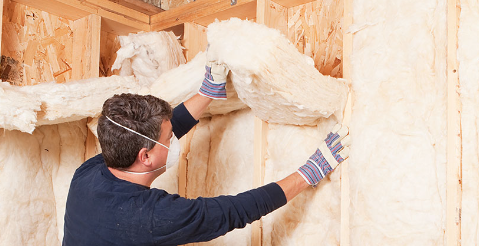
Finishing
If you plan to have electricity wired into the shed, you must do it before installing the insulation. Otherwise, you will have to remove the insulation, install the electrical wiring, and then put the insulation back up.
Pest Problems
The insulation makes the temperature inside the structure more pleasant for you. Hence, it also makes it more enjoyable for pests like rodents, snakes, and birds. The pests want to come inside and make their home. In fact, some pests will gravitate to the bats of fiberglass insulation as a great place to nest. You have to seal all possible holes or cracks to keep the building pest free, something that spray foam tends to do a good job of, but other types of insulation might need a little help.
Conclusion
Insulating your shed is a worthy investment. It saves you money because it protects the items you cherish enough to keep inside the shed.

